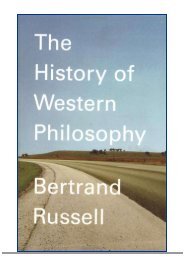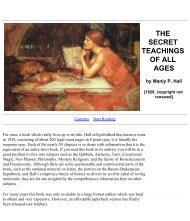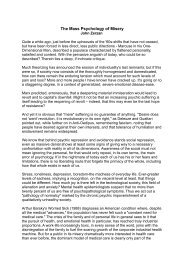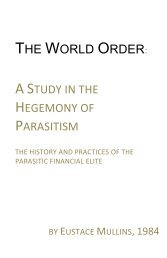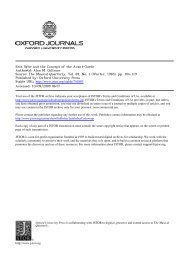The Ever-Present Origin - Michael Goodnight - Editor
The Ever-Present Origin - Michael Goodnight - Editor
The Ever-Present Origin - Michael Goodnight - Editor
- No tags were found...
You also want an ePaper? Increase the reach of your titles
YUMPU automatically turns print PDFs into web optimized ePapers that Google loves.
As we shall see, these designations are valid not only with respect to arthistory, but also to aesthetics, cultural history, and the history of thepsyche and the mind. <strong>The</strong> achievement of perspective indicates man'sdiscovery and consequent coming to awareness of space, whereas theunrealized perspective indicates that space is dormant in man and that heis not yet awakened to it. Moreover, the unperspectival world suggests astate in which man lacks self-identity: he belongs to a unit, such as a tribeor communal group, where the emphasis is not yet on the person but onthe impersonal, not an the "I" but on the communal group, the qualitativemode of the collective. <strong>The</strong> illuminated manuscripts and gilt ground ofearly Romanesque painting depict theunperspectival world that retainedthe prevailing constitutive elements of Mediterranean antiquity. Not untilthe Gothic, the forerunner of the Renaissance was there a shift inemphasis. Before that space is not yet our depth-space, rather a cavern(and vault), or simply an in-between space; in both instances it isundifferentiated space. This situation bespeaks for us a hardly conceivableenclosure in the world, an intimate bond between outer and innersuggestive of a correspondence — only faintly discernible —between souland nature. This condition was gradually destroyed by the expansion andgrowing strength of Christianity whose teaching of detachment fromnature transforms this destruction into an act of liberation.Man's lack of spatial awareness is attended by a lack of egoconsciousness,since in order to objectify and qualify space, a selfconscious"I" is required that is able to stand opposite or confront space,as well as to depict or represent it by projecting it out of his soul orpsyche. In this light, Worringer's statements regarding the lack of all spaceconsciousness in Egyptian art are perfectly valid: "Only in the rudimentaryform of prehistorical space and cave magic does space have a role inEgyptian architecture . . . . <strong>The</strong> Egyptians were neutral and indifferenttoward space . . . . <strong>The</strong>y were not even potentially aware of spatiality.<strong>The</strong>ir experience was not trans-spatial but pre-spatial; . . . their culture ofoasis cultivation was spaceless . . . . <strong>The</strong>ir culture knew only spatiallimitations and enclosures in architecture but no inwardness or interiorityas such. Just as their engraved reliefs lacked shadow depth, so too wastheir architecture devoid of special depth. <strong>The</strong> third dimension, that is theactual dimension of life's tension and polarity, was experience not as aquality but as a mere quantity. How then was space, the moment ofdepth-seeking extent, to enter their awareness as an independent qualityapart from all corporality? . . . <strong>The</strong> Egyptians lacked utterly any spatialconsciousness."Despite, or indeed because of, Euclidean geometry, there is no evidence ofan awareness of qualitative and objectified space in early antiquity or inthe epoch preceding the Renaissance. This has been indirectly confirmedby von Kaschnitz-Weinberg, who has documented two opposing yetcomplementary structural elements of ancient art as it emerged from theMegalithic (stone) age. <strong>The</strong> first, Dolmen architecture, entered theMediterranean region primarily from Northern and Western Europe and10




